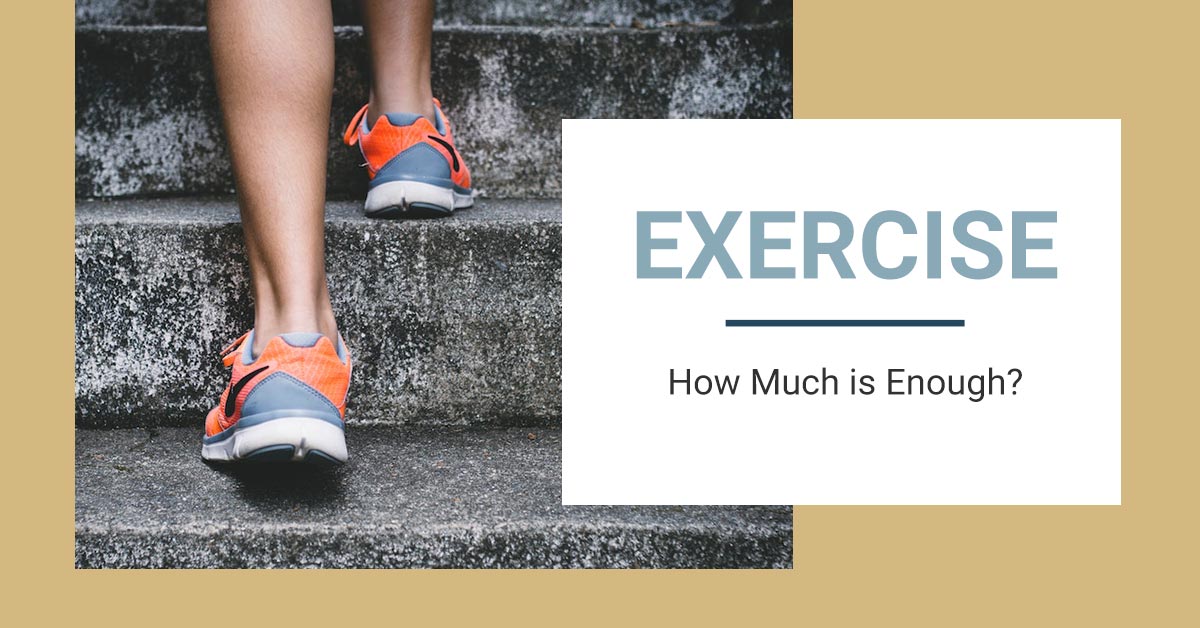
How Much Exercise is Enough?
Staying active is an important part of physical health. Regular exercise can help reduce the risk of heart disease, stroke, high blood pressure, cancer, type 2 diabetes and more. Regular exercise can also assist in developing strength, balance and can aid in the maintenance of developing healthy bones and muscles. To get this protection and reap the benefits of an active lifestyle, just how much exercise is enough?
Really, it depends on the health goals you have set for yourself and what you want to achieve from the exercise you wish to do. Some common goals are training for an event or competition, trying to control your weight, competing in elite sports or training for longevity (living longer with good quality years ahead). It’s important to understand that there are trade offs between different types of exercise and what they might mean for you, your body and your overall health.
Exercise Requirements for Competition
This will require an understanding of the requirements for the given event or competition you are choosing. For example training for a 10K run/race requires good levels of endurance. Not just aerobic endurance but also core stability and durability and also good form. It’s important to train with good form as this is where you will be more injury resilient. This might entail doing appropriate core exercises most days of the week with a few varied running sessions with different distances and speeds.
As your training capacity increases, it will be important to take a week off every 3-4 weeks to give your body time to heal and grow in strength. When we train to a point close to or where it exceeds our capacity to deal with the demand of the exercise we have performed (you may not directly feel this), it can cause microfractures in the bones, this requires time to heal so they can improve in their strength to tolerate more load from running.
If this isn’t honoured, injury can occur from overtraining. As you continue to work aerobically, your muscle fibres will adapt into slow twitch muscle fibres which are made for making you into an endurance machine. The trade off here is that you will lose speed and strength that you would achieve from fast twitch muscle fibres.
This is different from someone who might be training for a powerlifting competition who requires great explosive strength and core stiffness to lift heavy loads, ensuring that their spine doesn’t buckle under the pressure. For their bones to repair after sustaining high compressive loads, they may require a week off before their next heavy session to allow for the same repair as mentioned with running, though their capacity and need for recovery may arrive much sooner.
The trade off for high amounts of explosive strength and power is increased stiffness and a lack of mobility. To ensure these individuals can perform well, they may require mobility work focusing on their shoulders and hips. Of course, this is individual specific and this would need to be recommended by a professional with a thorough understanding of the individual’s anatomy and deficits. Powerlifters should not train mobility of their spine with activities like yoga as this will compromise their stability under high compressive load.
Exercise Requirements for Weight Control
While calories consumed is the greatest contributor to weight control, exercise is also a major factor in maintaining current weight levels or in shedding a bit of fat. Completing an hour of moderate exercise daily will make a difference in how you feel and look. There are small changes you can make throughout your day to get the hour, such as walking to nearby locations instead of driving, taking the stairs instead of an elevator, or parking further away from your destination and walking more.
Another great way to get your hour of exercise is to include weightlifting. Building muscle helps increase your body’s daily caloric requirements. Weightlifting helps to develop more strength and stability too. Look to add in 30 minutes of resistance training or weightlifting exercise 2-3 times a week. Adding in additional cardio exercises to weightlifting further helps the body boost its metabolic rate to help control weight.
Competing in Elite Sports
There are few of us who reach the realm of competing in elite sports. Having worked with many athletes, it is difficult for the average person to comprehend and truly understand what these individuals sacrifice to chase their dreams. The mental state required to reach these levels can become detrimental if they push themselves too far and sustain injury as a result. It really requires the athlete to be switched on 24/7 to maximise every opportunity to maximise performance. Being consciously aware of every movement to ensure they’re working towards their performance and not against it. There are few who gain this deeper level of understanding without appropriate coaching and these are often the individuals who excel and stand above the rest.
If this is something you wish to pursue, it’s important to understand the risk vs. reward pay off. The harder you train and push yourself in earlier life, the more likely you are to suffer in later years, this is well documented. For those who leave elite sports not on their terms, they can often struggle with identity problems and can find great difficulty in finding what their next step in life should be.
Exercise for Longevity
This is why we recommend for most people to train for longevity. In later years a lot of people struggle with hip, knee or back issues which can be attributed to poor movement habits adopted in earlier life. If you continually bend or perform repetitive tasks at home or at work, it can have a direct result on your joints and other tissues in later life.
It’s important to understand how your movement habits may be affecting you and you should train in a way that maximises the correct usage of these joints on a daily basis given your specific anatomy in order to protect them from injury.
Again, the important elements to this we want to consider are developing a balance between strength and mobility. A stable spine with mobile hips and shoulders can be achieved through the right core training and mobility work.
Yoga has become very popular in recent years for building strength and mobility. This originated in India and its primary focus was on achieving transcendence. This has since been taken out of context and adopted for the wider western population as a form of mobility training. India is one of the few countries in the world (among Japan and some eastern european countries like Poland and Ukraine) with a particularly high rate of hip dysplasia (shallow hip sockets). This gives them the gift of being able to maintain a neutral spinal posture in these extreme positions. Those who are unable due to having deeper hip sockets (more common in the UK, France and scandinavian countries), will tend to initiate more lumbar spine flexion (forward bending from the low back) in these positions. Over time this can delaminate (damage) the intervertebral discs, leading to hypermobility at each spinal segment. The trade off here is increased mobility, for reduced stability and ability to tolerate load.
Staying active is an important part of having a healthy heart, but also in every system in the body. For the average sized adult, the recommendation is
- 150 minutes per week, with the aerobic activity level being a moderate intensity, which can include walking, hiking or swimming to name a few. Spreading that time out through the week rather than all at once will bring the most benefit.
- Or, 75 minutes of vigorous activity like playing tennis or running fast enough to get out of breath where your heart rate is significantly increased.
These can be combined and could be broken down into doing 30 minutes of activity 5 days per week.
- Both of these should be combined with doing 2 days per week of appropriate strength training, focusing on your core, back, hips, shoulders, arms and legs.
Periods of sitting should be broken up at least every 30 minutes to assist in decreasing the effects of sedentary activities like reading, watching TV or spending time on the computer etc.
Children are also encouraged to be physically active. Between the ages of 3-5 years of age should be finding natural ways to be active with no set recommended time. Children 6-17 years old should be getting 60 minutes a day of physical activity.
Finding the Ideal Lifestyle
Everyone is going to have a different preference for staying healthy. Whether you prefer dancing, running, swimming, hiking, biking, or participating in organised sports, there are many activities that count as exercise. For healthy living, exercising is important. Find the activity that gets you excited and motivated to stay active.
Finding the right balance of exercise can be difficult as everyone’s needs depend on their goals. If you’re not sure or you feel that you may require a little assistance in getting things balanced in the right way, get in touch, we would love to offer some guidance and advice.
Resources:
1) McGill, S. (2015). Back Mechanic, The secrets to a healthy spine your doctor isn’t telling you. Canada:Backfitpro Inc..
2) McGill, S. and Carroll, B. (2018). Gift of Injury, The Strength Athlete’s Guide to Recovering from Back Injury and Winning Again. Canada:Backfitpro Inc..
3) Bull, FC. and the Expert Working Groups. (2010). Physical Activity Guidelines in the U.K.: Review and Recommendations. School of Sport, Exercise and Health Sciences, Loughborough University.


